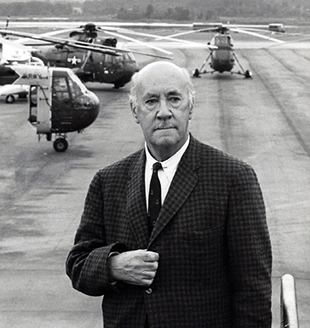

Igor I. Sikorsky (1889-1972)
“Creative work...remains a tremendously vital factor in the progress of mankind. The work of the individual still remains the spark which moves mankind
ahead.”
–Igor I. Sikorsky
National Medal of Science recipient in 1967 “for pioneering in the development of multi-engined aircraft, both land and sea planes, and for developing the helicopter as a useful and important device of aerial transportation.”
Igor I. Sikorsky was born in Kiev, Imperial Russia (now Ukraine). His father, a psychology professor, and his mother, a medical school graduate, encouraged Sikorsky to explore science at a young age. Sikorsky was inspired by the designs of Leonardo da Vinci and the writing of Jules Verne, who had imagined a helicopter-like vehicle in his book “Clipper of the Clouds.” Sikorsky took to heart Verne's declaration that “anything that one man can imagine, another man can make real.”
He began building model aircraft and, after learning about the Wright brothers’ accomplishments, he decided to pursue a career in aviation. Sikorsky traveled to Paris, then the aeronautical center of Europe, in 1909. He began designing and testing aircraft and succeeded in building the first four-engine airplane in 1913.
In 1919, Sikorsky immigrated to the United States due to the Russian Civil War and within four years, he had developed the Sikorsky Aero Engineering Corporation on what had been a chicken farm on Long Island, N.Y. Sikorsky quickly ran through his limited resources, while he and his workers worked by hand in the cold and retrieved parts from junkyards and five-and-dimes. With the corporation on its last legs, Sikorsky received a surprise visit from the Russian composer Sergei Rachmaninoff.
In an expression of support for his fellow countryman, Rachmaninoff gave Sikorsky a loan for $5,000 (approximately $100,000 today). In return, Sikorsky asked Rachmaninoff to be the vicepresident of the corporation, a position Rachmaninoff accepted. With Rachmaninoff’s backing, the corporation saw great success, and Sikorsky was able to pay back the $5,000, plus interest, in 1929.
After much trial and error, Sikorsky finished building the first working helicopter prototype, the VS-300, in 1939. He then designed the R-4, which in 1942 became the world’s first mass-produced helicopter. Though initial reception was mixed, the helicopter proved its worth during the Korean War, where it was used to rescue and transport soldiers who had been injured in combat.
“I always believed that the helicopter would be an outstanding vehicle for the greatest variety of lifesaving missions,” said Sikorsky, in a letter written the day before his death. “Now, near the close of my life, I have the satisfaction of knowing that this proved to be true.’ Sikorsky passed away in 1972.
Image descriptions and credits
Any opinions, findings, conclusions or recommendations presented in this material are only those of the presenter grantee/researcher, author, or
agency employee; and do not necessarily reflect the views of the National Science Foundation.


